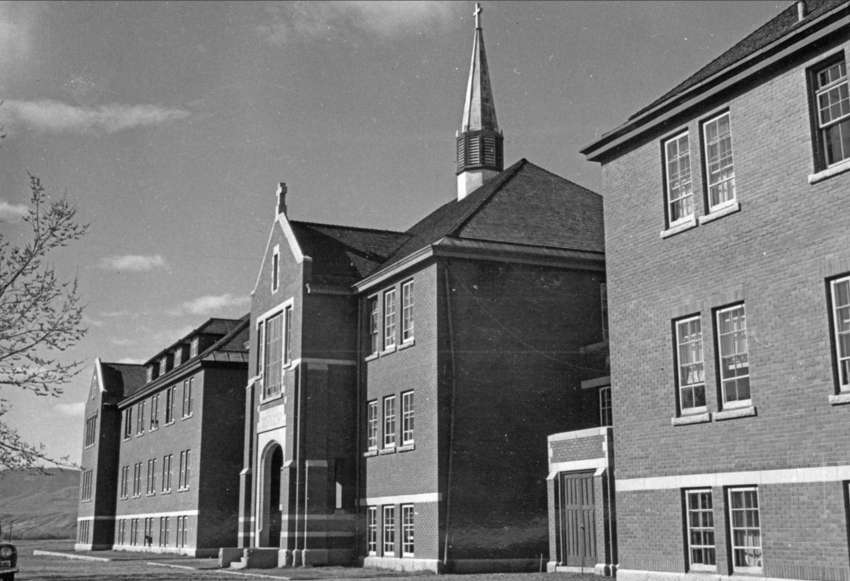Canadian Catholic News
Canada’s bishops are expressing their “deepest sorrow” and pledge to “continue walking side by side” with Indigenous people in the wake of the discovery of the bodies of 215 children buried at the site of a former residential school in Kamloops, B.C.
The Tk’emlúps te Secwépemc First Nation reported the “unthinkable loss” on May 27 that was “never documented” at the former Kamloops Indian Residential School. The school, funded by the federal government, was run by the Catholic Church from 1890 until 1969 before being shut down in 1978.
“The news of the recent discovery is shocking,” the Canadian Conference of Catholic Bishops said in a statement signed by it president, Archbishop Richard Gagnon of Winnipeg. “It rekindles trauma in numerous communities across this land. Honouring the dignity of the lost little ones remains that the truth be brought to light.”
News of the discovery prompted an outpouring of grief and shock across the country. Flags on all federal buildings, as well many municipal buildings, were lowered to half-mast in honour of the victims and vigils were held in several cities. In Vancouver, 215 pairs of children’s shoes were placed on the stops in front of the Vancouver Art Gallery as a memorial.
“As we see ever more clearly the pain and suffering of the past, the Bishops of Canada pledge to continue walking side by side with Indigenous peoples in the present, seeking greater healing and reconciliation for the future,” said Gagnon.
“We had a knowing in our community,” Tk’emlúps te Secwépemc First Nation chief Rosanne Casimir said of the discovery, which was verified with ground-penetrating radar. In a statement, Casimir said some of the children were as young as three years old.
“I am filled with deep sadness at the troubling news about the 215 children found buried at the Kamloops Indian Residential School,” Vancouver Archbishop J. Michael Miller said in the hours following news of the discovery.
“The pain that such news causes reminds us of our ongoing need to bring light to every tragic situation that occurred in residential schools run by the Church. The passage of time does not erase the suffering that touches the Indigenous communities affected, and we pledge to do whatever we can to heal that suffering.”
Kamloops Bishop Joseph Nguyen also expressed his sadness, saying “I humbly join so many who are heartbroken and horrified” by the news.
“On behalf of the Roman Catholic Diocese of Kamloops, I express my deepest sympathy to Chief Rosanne Casimir of the Tk’emlúps te Secwépemc Nation and to all who are mourning this tragedy and an unspeakable loss. No words of sorrow could adequately describe this horrific discovery,” he said.
Deacon Rennie Nahanee, former co-ordinator of the archdiocese’s First Nations Ministry Office and a member of the Squamish First Nation, took part in national Truth and Reconciliation Commission hearings in Vancouver in 2011 and heard “sad stories” of how the remains of children were sent home from residential schools.
“I presumed then that the remains were returned home,” he said.
Several questions need to be answered, he said, such as whether families were contacted upon the death of students, determining the Department of Indian Affairs policy regarding deaths at the schools, and whether family names were recorded so remains can now be returned to their communities.
The Kamloops Indian Residential School was the largest in the Indian Affairs residential school system, with enrolment reaching a high of 500 students in the early 1950s.
There were 51 documented deaths at the school between 1914 and 1963.
The school was one of five residential schools run by religious orders in the historical geographic boundaries of the Archdiocese of Vancouver. In 1945, with the establishment of the present-day Diocese of Kamloops, the school fell under the boundaries of the new diocese.
The Missionary Oblates of Mary Immaculate, who had teachers and administrators at the school, issued a statement May 30 expressing “heartfelt sadness and sincere regret for the deep pain and distress” that the discovery of the bodies brought to Indigenous communities. “The heart-breaking discovery brings the tragedy of the residential school system into the light once again and demands that we continue to confront its legacy,” said Fr. Ken Thorson, provincial of OMI Lacombe Canada.
The Tk’emlúps te Secwépemc Nation said next steps include working with a coroner, reaching out to communities whose children may have attended the school, protecting the locations of the remains, and seeking records of the deaths.
The tragedy of missing children, unmarked graves, and residential school cemeteries was documented by the Truth and Reconciliation Commission in 2013. Its final report, Honouring the Truth, included several calls to action, including the updating of records on the deaths of Aboriginal children, completion of a national student death register, and creation of an online registry of residential school cemeteries with maps showing the location of deceased residential school children.
“The mistreatment of Indigenous children is a tragic and shameful part of Canada’s history,” said a statement from Carolyn Bennett, minister of Crown-Indigenous Relations, and Marc Miller, minister of Indigenous Services. It added that the discovery of the bodies “is once again a reminder of the harms families and survivors have suffered and continue to suffer.

